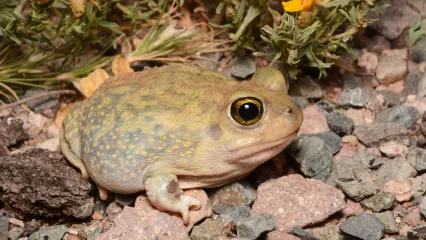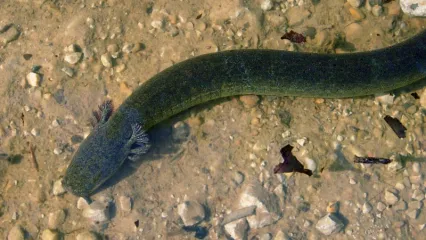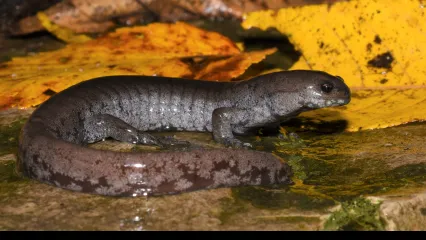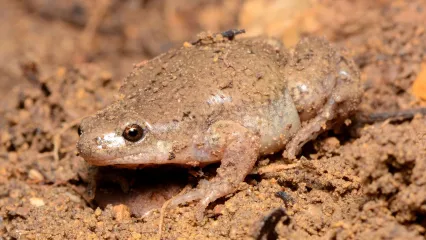
Description
The Couch’s spadefoot has smooth skin covered with evenly spaced tiny tubercles. The ground color of its back is pale green, yellow, or brown overlain with a medium to dark brown reticulate patter. Individuals vary considerably; some may have a plain dorsum, whereas others may have only a faint reticulate pattern. In general, its color is brighter than other spadefoots. The chin and belly are white to dirty white. Like other spadefoots, the eyes have vertical pupils. The iris is yellow with fine black reticulations near the outer edge. The common name is derived from the presence of a small “spade” on each hind foot. In this species, the spade is sickle-shaped.
The robust tadpoles have brown to nearly black bodies and tails overlain with fine gold chromatophores, giving them a brassy iridescent appearance. They eyes are located close together on top of the head. The fins are opaque with very fine black reticulations.
Size
Males range in size from about 2-2.7 inches. Females attain a larger size than males, and may reach over 3 inches in length.
Habitat
The Couch’s spadefoot is an amphibian of arid habitats. It occurs in short-grass prairies, creosote bush deserts, and mesquite savannahs. The Couch’s spadefoot occurs from southwest Oklahoma and central Texas into Mexico and Arizona to the extreme southeastern-most counties in California. It occurs south of California to the tip of Baja California.
Life Cycle
Adult spadefoots spend much of their time underground during dry periods. They use the sickle-shaped spades on their hind feet to dig burrows in sandy or soft soil. These frogs are summer breeders and move from their underground retreats to breeding sites in response to heavy rainfall, usually from April to August. Because they are moving in response to an external cue, nearly all adults arrive at the breeding sites at the same time and reproductive activity lasts for only a few days. This pattern is referred to as “explosive breeding,” in contrast to “prolonged breeding” which occurs in other kinds of frogs in which individuals migrate over a long period of time and reproductive activity lasts much longer (two to four months).
The Couch’s spadefoot breeds in ephemeral ponds, stock tanks, roadside ditches, small pools in streams, or most any other type of pool that forms after rainfall. Most individuals in a population breed during the first rains of the season, but a smaller number of individuals breed during subsequent rains. A single female can deposit about 3,000 eggs. Small masses of eggs are attached to plants and hatch within one day. Spadefoot tadpoles develop very fast, frequently transforming to froglets within 7 – 8 days. Desiccation is the major source of tadpole mortality; about 60 percent of all ponds in any region dry before the first froglets emerge.
In dry years when rainfall is not sufficient to trigger adult migration to the breeding sites, these frogs remain underground and do not reproduce. Males migrate to breeding ponds with the first heavy rain of the season. For several days, they call both during the day and at night. The call consists of short nots lasting about one second, repeated quickly at regular intervals. The call has a nasal quality and sounds like a low whine.
Like many other frogs, the Couch's spadefoot feeds on insects and spiders.
How To Observe
Like other spadefoots, Couch’s spadefoot is difficult to observe. These frogs come abroad only after periods of heavy rain. Choruses can be located by listening for the calls and tracking the sound to the breeding sites. Because the frogs are explosive breeders and use relatively small bodies of water in open areas, they are easy to locate once an active breeding population is found. When not breeding, individuals come above ground to feed after warm, summer rains. They can sometimes be found crossing roads on humid or wet nights.
(This profile was created by Dr. Laurie Vitt as part of a partnership between the Wildlife Department and the Sam Noble Oklahoma Museum of Natural History. It was funded as part of a larger grant to survey and inventory amphibians and reptiles of the Wildlife Management Areas of Oklahoma: T-35-P-1.)


